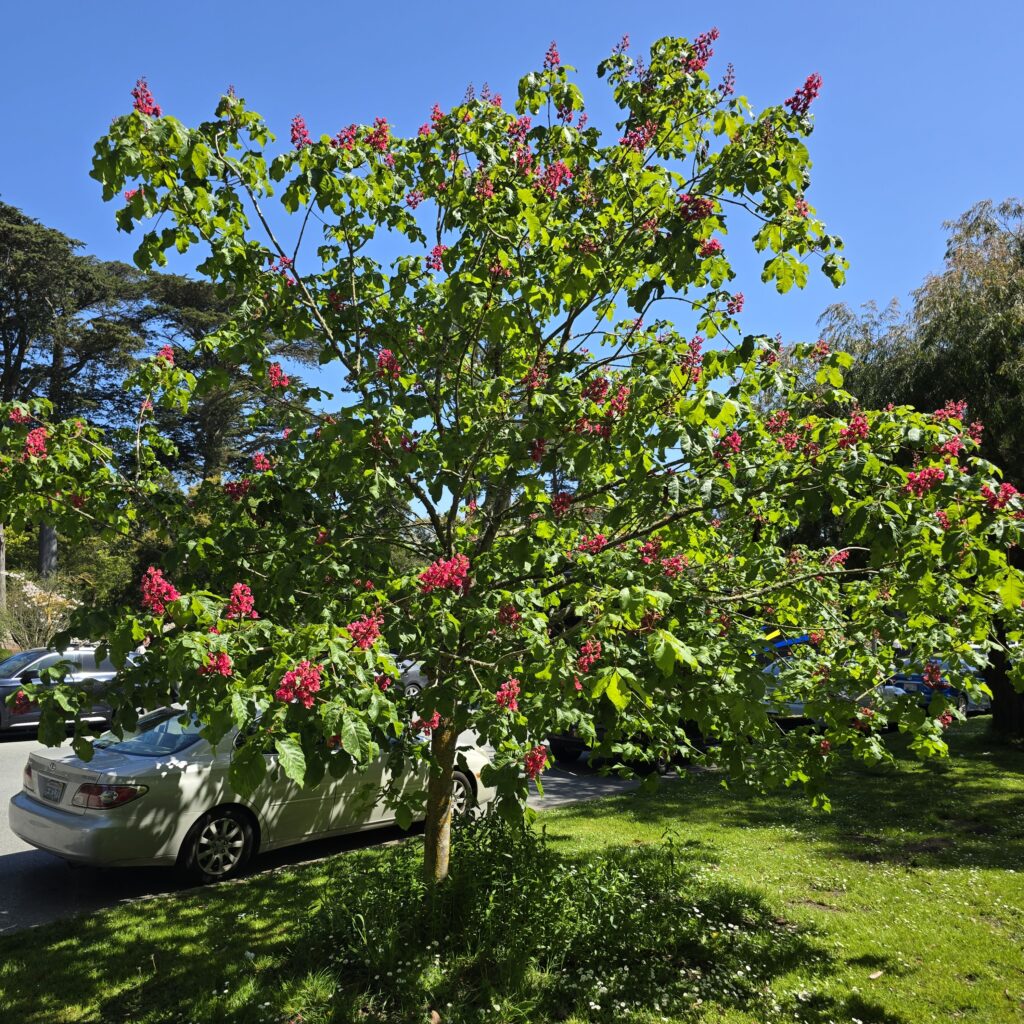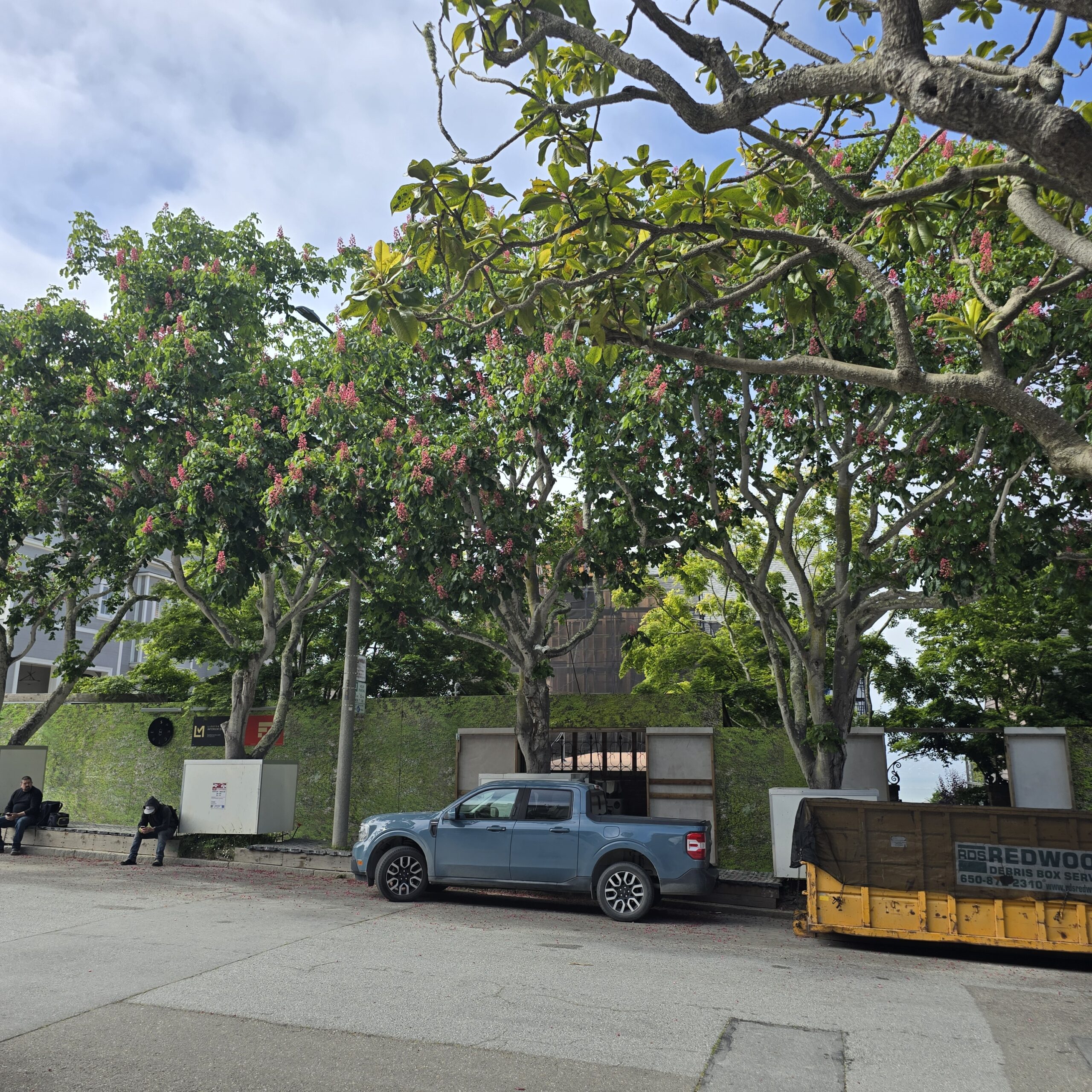The Red Horse Chestnut Tree: From European Gardens to San Francisco Streets
As a young man working in Switzerland, I spent countless hours tending to urban street trees—Linden, London plane, Celtis, Turkish hazel, and many more. European cities often feature rows of identical species shaped into pyramids, ovals, flattened canopies, or naturally full-grown crowns—just a few examples of the many forms seen across urban European landscapes. Of all the trees I worked on, the red-flowered horse chestnut tree(Aesculus × carnea) was always my favorite. It was the only one among them that truly celebrated spring—bursting into bloom with striking flower spikes. Long before I ever imagined I’d encounter them again in the foggy neighborhoods of San Francisco, I had already built a quiet affection for their beauty. Now, seeing a few newly planted along our boulevards feels like meeting an old friend from home – one that brings vivid memories and a rich story of transcontinental botany.

Origins: A Hybrid of Two Continents
Aesculus × carnea, commonly known as the red horse chestnut, is a hybrid between Aesculus hippocastanum (the white-flowered horse chestnut of the Balkans) and Aesculus pavia (the red buckeye from the southeastern United States). This cross was first recorded in Europe, likely in Germany, around 1812.
The result was an ornamental marvel – a tree that combined the stature and lush foliage of hippocastanum with the bold red flowers and improved drought tolerance of pavia. It became popular quickly in Europe, planted in palace grounds and along promenades for its showy appearance and more manageable size.
Botanical Highlights: Red Blossoms and Glossy Seeds
The red horse chestnut is beloved for its upright clusters of deep pink to red flowers, which bloom in late spring – typically May in San Francisco. These panicles are showy, fragrant, and attractive to pollinators like bees and hummingbirds.
Its foliage is dark green and palmate, with five leaflets per leaf (unlike the seven of hippocastanum), and the tree generally stays smaller – around 30–50 feet tall – making it ideal for urban settings. By late summer, it produces spiny green capsules containing large brown seeds, often called conkers. These seeds are not edible – in fact, they’re toxic to humans and most animals – but they add ornamental interest in fall.

Maintenance: Pollarding Tradition and Urban Management
In Europe, species of Aesculus – especially Aesculus hippocastanum and Aesculus × carnea – are often pollarded – a pruning method where the tree is cut back to a framework of branches to control its size and stimulate lush regrowth. I spent many seasons atop ladders, managing rows of these trees along city streets.
Pollarding, when started early and done correctly, can prolong the tree’s life, reduce breakage, and create a dramatic seasonal cycle. While this practice is rare in San Francisco, light pruning for shape and clearance may still be beneficial, especially during the dormant season.
Urban Resilience: Performance in San Francisco
San Francisco presents a mix of challenges and opportunities for Aesculus × carnea. The city’s cool summers and fog protect the tree from extreme heat, but our dry summers and strong winds can lead to leaf scorch or early leaf drop. The red horse chestnut is particularly susceptible to windburn, even in sheltered locations, and typically drops leaves by late summer as a stress response.
Despite this, the tree’s tolerance of urban pollution and compacted soils makes it viable for planting in city parks and wide streetscapes – especially if irrigation is provided during dry months. In my walks around the city, I’ve seen promising young specimens in places like Pacific Heights and the Richmond District, and the largest red horse chestnuts are proudly growing on Vallejo Street.

Tree Spotting: Where to Find Them in SF
While not common, Aesculus × carnea is making a small comeback in San Francisco. The city’s Urban Forestry Council lists it as a moderate-risk trial species, meaning it’s planted experimentally in select areas to see how it performs long-term. So far, it seems to do best in sheltered microclimates with summer irrigation.
A notable grouping can be found at 2828 Vallejo Street, where four mature red horse chestnuts burst into bloom each May, lighting up the sidewalk with coral-red flowers. These trees are among the best examples in the city and demonstrate the species’ potential when well-sited and cared for.

Closing Reflections: A Tree That Bridges Continents
Seeing Aesculus × carnea growing in San Francisco is more than just a botanical curiosity for me – it’s a bridge between two parts of my life. From pruning them in European town squares to watching them thrive (or struggle) in the Bay Area, this tree represents resilience, adaptation, and beauty across borders.
If you spot one in bloom, stop and admire it. Perhaps pick up a fallen conker in the fall – not to eat, but to remember that even in a modern city, trees can carry stories. The red horse chestnut’s tale stretches from Balkan mountains to Southern gardens to our fog-draped hills – and it’s just getting started here.
Next time you’re walking through San Francisco, see if you can spot a Red Horse Chestnut in bloom—and if you’re curious about adding one to your landscape, our arborists are here to help.


